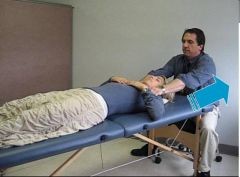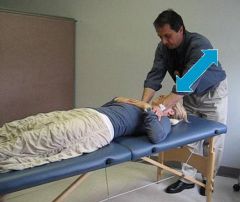![]()
![]()
![]()
Use LEFT and RIGHT arrow keys to navigate between flashcards;
Use UP and DOWN arrow keys to flip the card;
H to show hint;
A reads text to speech;
24 Cards in this Set
- Front
- Back
|
... techniques are when you take the body towards the restrictive barrier
|
direct
|
|
|
... techniques are when you take the body away from the restriction toward position of ease
|
indirect
|
|
|
the following describes what:
a direct technique that usually involves lateral stretching, linear stretching, deep pressure, traction and/or separation of proximal and distal muscle ends while monitoring tissue response and muscle changes by palpation. |
soft tissue technique
|
|
|
one of the proposed uses for soft tissue technique is to try and relax ... muscles
|
hypertonic
|
|
|
to improve local tissue nutrition, oxygenation, and removal of metabolic wastes and to enhance circulation to local myofascial structures you would use ...
|
soft tissue technique
|
|
|
to identify somatic dysfunction you can use ...
|
soft tissue techniques
|
|
|
soft tissue technique is also good for improving local and systemic ... responsiveness
|
immune
|
|
|
while doing soft tissue techniques, you should be feeling through ... by ...
|
layer
layer |
|
|
what does the below statement describe:
proximal and distal ends of the myofascial structures being treated are longitudinally separated |
tractional technique also called stretching
|
|
|
the statement below describes what:
a rhythmic, lateral stretching of a myofascial structure, in which proximal and distal ends are held stationary and the central portion of the structure is stretched like a bowstring. |
kneading
|
|
|
the statement below describes what:
sustained deep pressure over a hypertonic myofascial structure |
inhibition
|
|
|
Somatic dysfunction of the soft tissues (myofascial structures) of the body as characterized or inferred by ...
|
tissue texture changes
asymmetry restriction of motion tissue sensitivity or tenderness |
|
|
what does this describe:
Soft Tissue treatments produce generalized “tonic” effects on patients and enhance general physical tone and level of well-being |
tonic effect
|
|
|
what is a contraindication for soft tissue treatment
|
patient refusal
absence of somatic dysfunction skin disorders acute muscle strain acute ligament strain bone fracture thrombosis/bleeding disorders cancer |
|
|
while you are treating the patient you are also ...
|
diagnosing
|
|
|
the functions of the lymphatic system:
1. 2. 3. 4. |
1. Maintaining fluid balance
2. Purification and cleansing of tissues 3. Defense 4. Nutrition |
|
|
Lymph flows through lymph channels is influenced by three factors:
1. 2. 3. |
1. Interstitial fluid pressure-forces fluid into the lymph capillaries
2. Ionic Gradients- fluid goes toward higher concentrations 3. Intrinsic lymphatic pump-channels |
|
|
Direct external pressure on the lymph channel ... the flow of lymph.
|
increases
|
|
|
diaphragm is an important external ... of the lymphatic system.
|
pump
|
|
|
there are 2 types of omt treatment for lymphatics:
1. 2. |
1. remove impedance to lymphatic flow
2. augment and improve the flow of lymph |
|
|
what does rib raising do:
|
reduces constriction of larger lymph vessels, while reducing sympathetic tone
|
|

what is this technique called:
|

pectoral traction
|
|

what is the name of this technique:
|

thoracic pump
|
|
|
absolute contraindications for lymphatic techniques
1. 2. |
Anuresis if not on dialysis
Necrotizing fasciitis |

